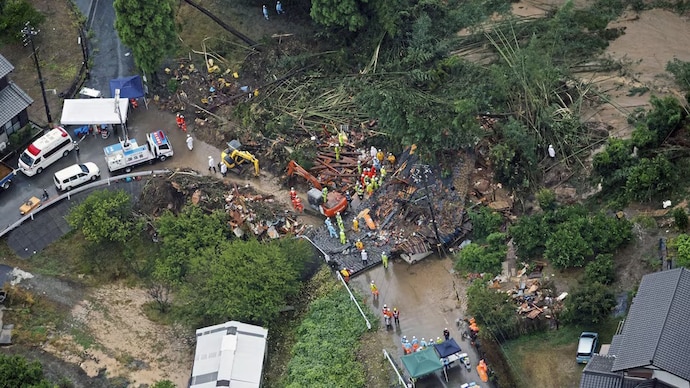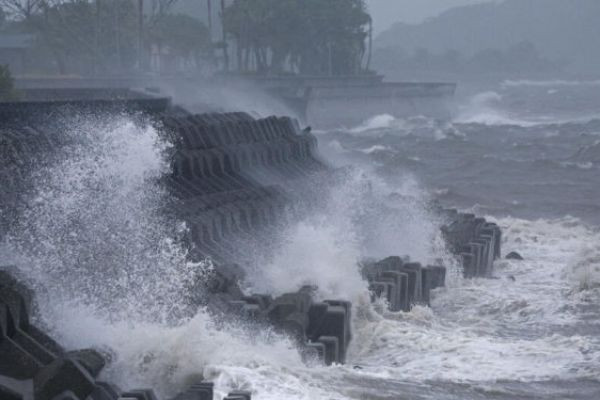Typhoon Shanshan, a powerful tropical cyclone, made landfall in southern Japan in late August 2024, bringing with it torrential rains, fierce winds, and widespread devastation. This storm, one of the most severe to hit the region in recent years, has left a trail of destruction in its wake, disrupting lives, causing significant damage to infrastructure, and challenging the resilience of communities across the affected areas. As Japan grapples with the aftermath of Typhoon Shanshan, the storm serves as a stark reminder of the increasing frequency and intensity of extreme weather events in a changing climate.
Formation and Path of Typhoon Shanshan
Typhoon Shanshan originated in the western Pacific Ocean, forming from a tropical depression that rapidly intensified into a typhoon due to favorable atmospheric conditions, including warm sea surface temperatures and low vertical wind shear. The storm quickly gained strength as it moved northwestward, following a path that would eventually bring it into direct contact with Japan's southern islands.
By the time Shanshan approached Japan, it had reached Category 4 status, with sustained winds exceeding 150 km/h (93 mph) and gusts even stronger. The Japan Meteorological Agency (JMA) issued warnings well in advance, alerting residents and authorities to the impending danger. The storm's path took it close to Okinawa before making landfall on Kyushu, Japan's southernmost main island, where it caused the most significant damage.
Impact on Southern Japan
As Typhoon Shanshan made landfall, it unleashed heavy rainfall, with some areas recording more than 500 millimeters (20 inches) of rain in just 24 hours. This deluge triggered widespread flooding, particularly in low-lying regions, where rivers quickly overflowed their banks, inundating homes, roads, and agricultural lands. The combination of intense rainfall and strong winds led to numerous landslides, further exacerbating the destruction.
One of the hardest-hit areas was the city of Kagoshima, where the storm's fury was felt most acutely. The city's coastal areas were battered by powerful storm surges, which caused extensive damage to infrastructure, including ports, bridges, and coastal defenses. In addition to the physical damage, the storm surge also led to saltwater intrusion into freshwater sources, complicating the recovery efforts for local communities dependent on these resources.
The storm's impact was not limited to Kagoshima. Throughout southern Japan, thousands of homes were damaged or destroyed, leaving many residents displaced and seeking shelter in emergency facilities. The agricultural sector also suffered severe losses, with crops such as rice, vegetables, and fruits devastated by the flooding and wind damage. The economic toll of the storm is expected to be substantial, with early estimates suggesting losses in the billions of yen.

Response and Recovery Efforts
In the face of such widespread devastation, Japan's emergency response systems were quickly mobilized. The government, working in coordination with local authorities and disaster relief organizations, deployed thousands of personnel to assist in search and rescue operations, provide medical care, and deliver essential supplies to affected communities. The Self-Defense Forces were also called in to help with the evacuation of residents from the most severely impacted areas and to assist in clearing debris and restoring vital infrastructure.
The swift response was crucial in minimizing the loss of life. Despite the severity of the storm, the death toll remained relatively low, a testament to Japan's advanced disaster preparedness and early warning systems. However, the challenges posed by Typhoon Shanshan extended beyond the immediate response phase. The recovery process, particularly in the hardest-hit regions, is expected to be long and complex, requiring substantial resources and coordination.
One of the immediate concerns following the storm was the restoration of power and water supplies. The typhoon caused widespread power outages, affecting millions of households across southern Japan. Repair crews worked around the clock to restore electricity, but the extent of the damage meant that some areas remained without power for days. Similarly, the flooding and landslides disrupted water supply systems, leading to shortages in some communities. Emergency measures, including the distribution of bottled water and the setup of temporary water supply stations, were implemented to address these shortages.
Environmental and Long-Term Impacts
The environmental impact of Typhoon Shanshan is also a significant concern. The storm's heavy rains and strong winds caused severe soil erosion, particularly in mountainous regions, where landslides stripped away vegetation and destabilized slopes. This erosion not only threatens the natural environment but also poses a long-term risk to infrastructure and human settlements in these areas.
The flooding caused by Shanshan has also had a profound impact on Japan's ecosystems. Coastal wetlands, which serve as critical habitats for a variety of species, were inundated by the storm surge, leading to the loss of biodiversity and the disruption of ecological processes. In agricultural areas, the flooding of fields has led to the contamination of soil with saltwater and pollutants, which could affect crop yields for years to come.
In the longer term, Typhoon Shanshan raises important questions about the resilience of Japan's infrastructure and communities in the face of increasingly severe weather events. The storm has highlighted vulnerabilities in the country's coastal defenses, urban planning, and disaster response systems, which will need to be addressed to mitigate the impact of future storms.

Climate Change and the Increasing Intensity of Typhoons
The devastation wrought by Typhoon Shanshan is part of a broader pattern of increasingly intense and frequent tropical cyclones in the western Pacific, a trend that scientists attribute to climate change. As global temperatures rise, the oceans are warming, providing more energy for the development of powerful storms like Shanshan. In addition, changing atmospheric patterns are altering the paths and intensities of these storms, making them more unpredictable and potentially more destructive.
Japan, with its long history of dealing with typhoons, is acutely aware of these changes. The country has invested heavily in disaster preparedness, from building robust coastal defenses to developing sophisticated early warning systems. However, as Typhoon Shanshan has demonstrated, even the best-prepared nations can be caught off guard by the sheer power of nature. The storm has prompted renewed discussions about the need to adapt to a changing climate, including the possibility of relocating vulnerable communities, upgrading infrastructure, and enhancing disaster response capabilities.
Community Resilience and Lessons Learned
Despite the devastation caused by Typhoon Shanshan, the resilience of the affected communities has been remarkable. In the days following the storm, stories of neighbors helping neighbors, volunteers organizing relief efforts, and local businesses providing free services to those in need have emerged, highlighting the strength and solidarity of the Japanese people in the face of adversity.
One of the key lessons from Shanshan is the importance of community-based disaster preparedness. In many areas, local disaster preparedness committees, which had been trained in evacuation procedures and emergency response, played a crucial role in ensuring the safety of residents. These grassroots efforts, combined with the support of national and international organizations, underscore the importance of a multi-level approach to disaster management.
Looking ahead, the experience of Typhoon Shanshan will likely lead to a reassessment of disaster preparedness strategies in Japan. This could include the development of more resilient infrastructure, improved early warning systems, and greater emphasis on climate adaptation measures. For communities in southern Japan, the recovery process will be an opportunity not only to rebuild but also to strengthen their resilience to future storms.
Conclusion
Typhoon Shanshan has left an indelible mark on southern Japan, both in terms of the physical destruction it caused and the broader implications for disaster preparedness in an era of climate change. While the storm's immediate impacts were devastating, the response and recovery efforts have demonstrated Japan's capacity for resilience and adaptation. As the country rebuilds, the lessons learned from Shanshan will be crucial in preparing for the future, ensuring that communities are better equipped to face the challenges posed by an increasingly volatile climate.
In the end, Typhoon Shanshan serves as a powerful reminder of the delicate balance between humanity and nature, and the ongoing need to adapt to the changing environment. For Japan, and indeed for the world, the storm is a call to action, urging us to confront the realities of climate change and to take proactive steps to protect our communities from the growing threat of extreme weather events.



